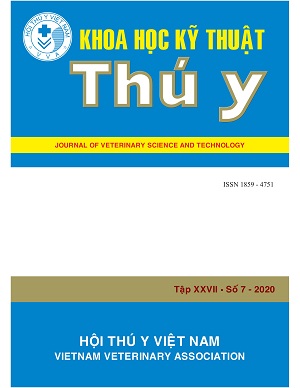Prevalence of coccidiosis in colored feather chickens raising at semi-industrial method in Hau Giang province
Abstract
The situation of Coccidia infection in the colored feather chickens raising at the semi-industrial method in Phung Hiep and Long My districts of Hau Giang province was conducted from August 2018 to May 2019. A total of 3,840 fecal samples of chickens from 1 to 12 weeks old at Phung Hiep and
Long My district farms were collected as the research materials. The research methods were applied, such as floating, measuring oocyst size, counting the number of oocyst per a gram of feces, monitoring sporulation time, tracking symptoms and lesions, and identifying species by routine methods. The studied result showed that the chickens raised in Hau Giang province were infected with chicken Coccidia at a relatively high rate (48.76%). The infection rate of chickens with coccidia increased
gradually by age groups. The infection rate of chickens with oocysts at 1 week old were not found. For the chickens at 2 weeks old, the infection rate with oocysts was 37.50% (chickens raising in Phung Hiep district) and 34.38% (chickens raising in Long My district); similary, the infection rate of the chickens at 3 weeks old was 60.63% (chickens raising in Phung Hiep district) and 51.25% (chickens raising in Long My district) and the highest infection rate of chickens was at 4 weeks old (95.63% in Phung Hiep district and 98.75% in Long My district). The infection intensity was at level 3+ and 4+ increasing by age groups and reached the highest point at 4, 5 weeks old. The chickens raising in Hau Giang province were infected with 4 Coccidia species, such as: E. acervulina, E. necatrix, E. maxima and E.
tenella. At the time that the chickens were infected with a heavy intensity, the clinical signs included inactiveness, watery diarrhea with mucus, bloody or creamy exudate feces, ballooned caecum and thinned intestines. The lesions were concentrated in the intestines, such as hemorrhage of the entire caecum, the small intestine was thickened, presenting gray spots; the wall of the small intestine was enlarged and thick, bleeding. The intestines discharged a lot of brown mucus. The E. tenella species
caused the most common disease and accounted for the highest infection rate. The chicken flocks in Hau Giang province were infected at the same time with 3-4 species of Coccidia

